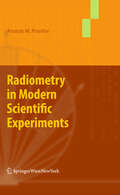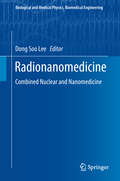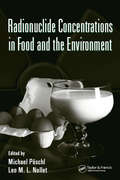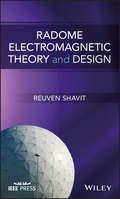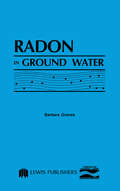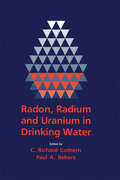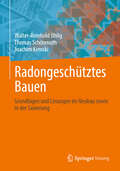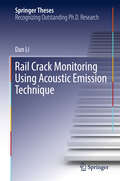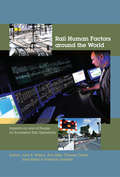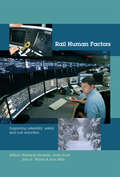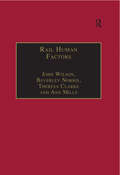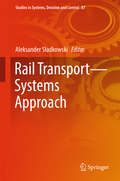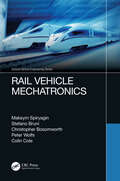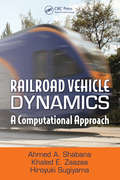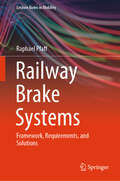- Table View
- List View
Radiometry in Modern Scientific Experiments
by Pravilov AnatolyThe reader is provided with information about methods of calibration of light sources and photodetectors as well as responsiveness of spectral instruments ranging from near infrared to vacuum UV spectral, 1200 - 100 nm, and radiation intensities of up to several quanta per second in absolute and arbitrary units. The author describes for the first time original methods of measurements they created and draws upon over 40 years of experience in working with light sources and detectors to provide accurate and precise measurements. This book is the first to cover these aspects of radiometry and is divided into seven chapters that examine information about terminology, units, light sources and detectors, methods, including author's original ones, of absolute calibration of detectors, spectral instruments responsiveness, absolute measurements of radiation intensity of photoprocesses, and original methods of their study. Of interest to researchers measuring; luminescence spectra, light intensities from IR to vacuum UV, spectral range in wide-light intensity ranges, calibrate light sources and detectors, absolute or relative quantum yields of photoprocess determination.
Radiomics and Radiogenomics: Technical Basis and Clinical Applications (Imaging in Medical Diagnosis and Therapy)
by Ruijiang Li, Lei Xing, Sandy Napel and Daniel L. RubinRadiomics and Radiogenomics: Technical Basis and Clinical Applications provides a first summary of the overlapping fields of radiomics and radiogenomics, showcasing how they are being used to evaluate disease characteristics and correlate with treatment response and patient prognosis. It explains the fundamental principles, technical bases, and clinical applications with a focus on oncology. The book’s expert authors present computational approaches for extracting imaging features that help to detect and characterize disease tissues for improving diagnosis, prognosis, and evaluation of therapy response. This book is intended for audiences including imaging scientists, medical physicists, as well as medical professionals and specialists such as diagnostic radiologists, radiation oncologists, and medical oncologists. Features Provides a first complete overview of the technical underpinnings and clinical applications of radiomics and radiogenomics Shows how they are improving diagnostic and prognostic decisions with greater efficacy Discusses the image informatics, quantitative imaging, feature extraction, predictive modeling, software tools, and other key areas Covers applications in oncology and beyond, covering all major disease sites in separate chapters Includes an introduction to basic principles and discussion of emerging research directions with a roadmap to clinical translation
Radionanomedicine: Combined Nuclear And Nanomedicine (Biological and Medical Physics, Biomedical Engineering)
by Dong Soo LeeThis book describes radionanomedicine as an integrated medicine using exogenous and endogenous This book describes radionanomedicine as an integrated approach that uses exogenous and endogenous nanomaterials for in vivo and human applications. It comprehensively explains radionanomedicine comprising nuclear and nanomedicine, demonstrating that it is more than radionanodrugs and that radionanomedicine also takes advantage of nuclear medicine using trace technology, in which miniscule amounts of materials and tracer kinetic elucidate in vivo biodistribution. It also discusses exogenous nanomaterials such as inorganic silica, iron oxide, upconversion nanoparticles and quantum dots or organic liposomes labelled with radioisotopes, and radionanomaterials used for targeted delivery and imaging for theranostic purposes. Further, it examines endogenous nanomaterials i.e. extracellular vesicles labelled with radioisotopes, known as radiolabelled extracellular vesicles, as well as positron emission tomography (PET) and single photon emission computed tomography (SPECT), which elucidate the biodistribution and potential for therapeutic success.
Radionuclide Concentrations in Food and the Environment
by Leo M. L. Nollet Michael PoschlAs radiological residue, both naturally occurring and technologically driven, works its way through the ecosystem, we see its negative effects on the human population. Radionuclide Concentrations in Food and the Environment addresses the key issues concerning the relationship between natural and manmade sources of environmental radioactivity
Radionuclide Contamination and Remediation Through Plants
by Clemens Walther Dharmendra Kumar GuptaThis book focuses on the mechanistic (microscopic) understanding of radionuclide uptake by plants in contaminated soils and potential use of phytoremediation. The key features concern radionuclide toxicity in plants, how the radioactive materials are absorbed by plants, and how the plants cope with the toxic responses. The respective chapters examine soil classification, natural plant selection, speciation of actinides, kinetic modeling, and case studies on cesium uptake after radiation accidents. Radionuclide contaminants pose serious problems for biological systems, due to their chemical toxicity and radiological effects. The processes by which radionuclides can be incorporated into vegetation can either originate from activity interception by external plant surfaces (either directly from the atmosphere or from resuspended material), or through uptake of radionuclides via the root system. Subsequent transfer of toxic elements to the human food chain is a concrete danger. Therefore, the molecular mechanisms and genetic basis of transport into and within plants needs to be understood for two reasons: The effectiveness of radionuclide uptake into crop plants - so-called transfer coefficient - is a prerequisite for the calculation of dose due to the food path. On the other hand, efficient radionuclide transfer into plants can be made use of for decontamination of land - so-called phytoremediation, the direct use of living, green plants for in situ removal of pollutants from the environment or to reduce their concentrations to harmless levels.
Radionuclide and Metal Sorption on Cement and Concrete
by Michael Ochs Dirk Mallants Lian WangCementitious materials are being widely used as solidification/stabilisation and barrier materials for a variety of chemical and radioactive wastes, primarily due to their favourable retention properties for metals, radionuclides and other contaminants. The retention properties result from various mineral phases in hydrated cement that possess a high density and diversity of reactive sites for the fixation of contaminants through a variety of sorption and incorporation reactions. This book presents a state of the art review and critical evaluation of the type and magnitude of the various sorption and incorporation processes in hydrated cement systems for twenty-five elements relevant for a broad range of radioactive and industrial wastes. Effects of cement evolution or ageing on sorption/incorporation processes are explicitly evaluated and quantified. While the immobilisation of contaminants by mixing-in during hydration is not explicitly addressed, the underlying chemical processes are similar. A quantitative database on the solid/liquid distribution behaviour of radionuclides and other elements in hydrated cement systems is established on the basis of a consistent review and re-evaluation of literature data. In addition to recommended values, all underlying original experimental data and key experimental info rmation are provided, which allows users to trace the given recommendations or to develop their own set of key values. This database is closely tied to the safety analysis of near surface disposal of radioactive waste in Belgium. It focuses on radioelements, toxic stable elements and heavy metals, which makes it relevant for investigations involving the interaction of radioactive and conventional contaminants with cement-based barriers.
Radiophysical and Geomagnetic Effects of Rocket Burn and Launch in the Near-the-Earth Environment
by Nathan Blaunstein Leonid F. ChernogorRadiophysical and Geomagnetic Effects of Rocket Burn and Launch in the Near-the-Earth Environment describes experimental and theoretical studies on the effects of rocket burns and launchings on the near-the-Earth environment and geomagnetic fields. It illuminates the main geophysical and radiophysical effects on the ionosphere and magnetosphere sur
Radium Girls: Women and Industrial Health Reform, 1910–1935
by Claudia ClarkIn the early twentieth century, a group of women workers hired to apply luminous paint to watch faces and instrument dials found themselves among the first victims of radium poisoning. Claudia Clark's book tells the compelling story of these women, who at first had no idea that the tedious task of dialpainting was any different from the other factory jobs available to them. But after repeated exposure to the radium-laced paint, they began to develop mysterious, often fatal illnesses that they traced to conditions in the workplace. Their fight to have their symptoms recognized as an industrial disease represents an important chapter in the history of modern health and labor policy. <p><p> Clark's account emphasizes the social and political factors that influenced the responses of the workers, managers, government officials, medical specialists, and legal authorities involved in the case. She enriches the story by exploring contemporary disputes over workplace control, government intervention, and industry-backed medical research. Finally, in appraising the dialpainters' campaign to secure compensation and prevention of further incidents--efforts launched with the help of the reform-minded, middle-class women of the Consumers' League--Clark is able to evaluate the achievements and shortcomings of the industrial health movement as a whole.
Radome Electromagnetic Theory and Design (Wiley - IEEE)
by Reuven ShavitRadome Electromagnetic Theory and Design explores the theoretical tools and methods required to design radomes that are fully transparent to the electromagnetic energy transmitted or received by the enclosed antenna. A radome is a weatherproof and camouflaged enclosure that protects the enclosed radar or communication antenna, and are typically used on a fixed or moving platform such as an aircraft, ship or missile. The author — a noted expert in the field — examines the theoretical methods that apply to all type of radomes: planar, conformal, airborne and ground based. The text offers a description of the various measurement methods that characterise the electrical parameters of a radome, and discusses their merits in terms of accuracy. This groundbreaking book brings together in one volume all the necessary theoretical tools to design radomes
Radon in Ground Water
by National Water Well Assoc.This new book focuses on sampling and analysis, radon and radium in water supply wells, predictive models, geologic and hydrogeologic controls that influence radon occurrence, monitoring radon and other radioactivity from geologic sources and mining impacts on occurrence of radioactivity in ground water. Also discussed are occurrence, testing, treatment, and reduction of radon from groundwater. Because the most severe health hazard from indoor radioactivity results from inhalation of short-lived radioactive decay products of radon, the EPA scheduled a major conference early in 1987 on Radon, Radium, and Other Radioactivity in Ground Water-Hydrogeologic Impact and Application to Indoor Airborne Contamination. The result is this book.
Radon, Radium, and Uranium in Drinking Water
by C. Richard CothernWith new regulations for radionuclides in drinking water, this volume will be valuable for understanding where radionuclides come from, how their prescence is determined, where humans come in contact with them, health effects consequences (both for individuals and communities), removal from water, disposal problems and cost implications.
Radongeschütztes Bauen: Grundlagen und Lösungen im Neubau sowie in der Sanierung
by Walter-Reinhold Uhlig Thomas Schönmuth Joachim KemskiDas Thema des radonsicheren Bauens und Sanierens ist spätestens mit dem 2017 beschlossenen und 2018 in Kraft getretenen neuen deutschen Strahlenschutzgesetz im Bauen angekommen. Der Schutz vor erhöhter Radonkonzentration in der Raumluft ist aber schon seit geraumer Zeit ein wichtiges Thema, da die gesundheitlichen Gefährdungen, die durch eine hohe Radonkonzentration in der Raumluft entstehen, seit vielen Jahren bekannt und sehr gut dokumentiert sind.In der Veröffentlichung wird ein umfassender Überblick über die Grundlagen des Radonschutzes, die Messung von Radon in der Raumluft sowie alle heute bekannten und erprobten baulichen und lüftungstechnischen Lösungen des Radonschutzes sowie deren Anwendung im Neubau und der Sanierung gegeben. Damit wird allen in der Planung und Bauausführung Tätigen ein wichtiges Kompendium an die Hand gegeben, um dieses noch relativ neue Thema sicher und in einem wirtschaftlich vertretbaren Rahmen in Planung und Bauausführung umzusetzen.
Ragdoll: Now a major TV series (A Ragdoll Book #1)
by Daniel ColeOne body. Six victims.'The race is on in this highly anticipated debut.' Metro'A brilliant, breathless thriller. If you liked Se7en, you'll love this!' M.J. Arlidge'A high concept solution to a mystery' Sophie Hannah'An exciting thriller' Linwood Barclay A body is discovered with the dismembered parts of six victims stitched together, nicknamed by the press as the 'Ragdoll'. Assigned to the shocking case are Detective William 'Wolf' Fawkes, recently reinstated to the London Met, and his former partner Detective Emily Baxter.The 'Ragdoll Killer' taunts the police by releasing a list of names to the media, and the dates on which he intends to murder them. With six people to save, can Fawkes and Baxter catch a killer when the world is watching their every move?Translated into over 30 languages, RAGDOLL is a quality, rocket-paced thriller with twists and turns you won't see coming. For readers of Jo Nesbo. You will not stop talking about this book.What everyone is saying about RAGDOLL:'A star is born. Killer plot. Killer pace. Twisted killer and a killer twist. Kill to get a copy.' Simon Toyne'...the best debut I've ever read.' Rachel Abbott'This book kept me captivated, my heart pumping and guessing to the very end!' NetGalley reviewerRead by Andrew Wincott(p) 2017 Orion Publishing Group
Ragdoll: Soon to be a major TV series (A Ragdoll Book #1)
by Daniel Cole'A twisted killer and a killer twist. Kill to get a copy' Simon Toyne, bestselling author of The Boy Who Saw A body is discovered with six victims stitched together, nicknamed by the press as the 'Ragdoll'. Assigned to the shocking case are Detective William 'Wolf' Fawkes, recently reinstated to the London Met, and his former partner Detective Emily Baxter.The 'Ragdoll Killer' taunts the police by releasing a list of names to the media, and the dates on which he intends to murder them. With six people to save, can Fawkes and Baxter catch a killer when the world is watching their every move?'A brilliant, breathless thriller' M.J. Arlidge, bestselling author of Down to the WoodsPerfect for fans of MJ Arlidge, JP Delaney, Steve Cavanagh, Chris Carter and Helen FieldsReaders LOVE Ragdoll . . . 'This book kept me captivated, my heart pumping and guessing to the very end!' '...a rollercoaster of a thriller.' '...one of the most well written crime thrillers I have ever read''A very well written debut novel which had all the twists and turns and intrigue that you need.' 'Totally unputdownable'
Rail Crack Monitoring Using Acoustic Emission Technique (Springer Theses)
by Dan LiThis thesis provides an innovative strategy for rail crack monitoring using the acoustic emission (AE) technique. The field study presented is a significant improvement on laboratory studies in the literature in terms of complex rail profile and crack conditions as well as high operational noise. AE waves induced by crack propagation, crack closure, wheel-rail impact and operational noise were obtained through a series of laboratory and field tests, and analyzed by wavelet transform (WT) and synchrosqueezed wavelet transform (SWT). A wavelet power-based index and the enhanced SWT scalogram were sequentially proposed to classify AE waves induced by different mechanisms according to their energy distributions in the time–frequency domain. A novel crack sizing method taking advantage of crack closure-induced AE waves was developed based on fatigue tests in the laboratory. The propagation characteristics of AE waves in the rail were investigated, and Tsallis synchrosqueezed wavelet entropy (TSWE) with time was finally brought forward to detect and locate rail cracks in the field. The proposed strategy for detection, location and sizing of rail cracks helps to ensure the safe and smooth operation of the railway system. This thesis is of interest to graduate students, researchers and practitioners in the area of structural health monitoring.
Rail Human Factors around the World: Impacts on and of People for Successful Rail Operations
by John R. Wilson Ann Mills Nastaran Dadashi Jane Rajan Theresa ClarkeThe rail human factors/ergonomics community has grown quickly and extensively, and there is much increased recognition of the vital importance of ergonomics/human factors by rail infrastructure owners, rail operating companies, system developers, regulators and national and trans-national government. This book, the third on rail human factors, is d
Rail Human Factors: Supporting reliability, safety and cost reduction
by John R. Wilson Ann Mills Nastaran Dadashi Anita ScottThe rail human factors/ergonomics community has grown quickly and extensively, and there is much increased recognition of the vital importance of ergonomics/human factors by rail infrastructure owners, rail operating companies, system developers, regulators and national and trans-national government. This book, the fourth on rail human factors, is
Rail Human Factors: Supporting the Integrated Railway
by Ann Mills J Wilson B NorrisIn recent years, for reasons connected to the organization of the industry, technical developments, and major safety concerns, rail human factors has grown in importance at an international level. Despite its importance, however, supporting literature has been largely restricted to specialist journal publications and technical reports. Rail Human Factors addresses this imbalance by providing the first fully comprehensive overview of the area. The volume includes contributions from leading ergonomists, psychologists, sociologists, management scientists and engineers whose common theme is to investigate, understand and design for people on the railways, including staff, passengers and the general public. Every area of ergonomics/human factors is covered: physical design of work and equipment in maintenance; cognitive ergonomics in driving, signalling and control; organizational and social ergonomics in the way teams are formed, plans are made and organizations are structured and run. Topics covered include: � Systems views of rail human factors � Driver models and performance � Train and cab design � Network and train control systems, including ERTMS � Signals and signal � SPADS � Signalling and control center design � Signaller performance � Control center interfaces � Workload, situation awareness, team working � Human error and reliability � Timetabling and planning � Maintenance planning and work � Safety climate and safety culture � Passenger comfort and behaviour � Station design � Public information systems � Level crossings � Trespass and vandalism � Ergonomics standards and guidelines � Human Factors integration The book is the definitive guide for all those concerned with making railways safer, more
Rail Transport—Systems Approach
by Aleksander SładkowskiThis book shows how the systems approach is employed by scientists in various countries to solve specific problems concerning railway transport. In particular, the book describes the experiences of scientists from Romania, Germany, the Czech Republic, the UK, Russia, Ukraine, Lithuania and Poland. For many of these countries there is a problem with the historical differences between the railways. In particular, there are railways with different rail gauges, with different signaling and communication systems, with different energy supplies and, finally, with different political systems, which are reflected in the different approaches to the management of railway economies. The book’s content is divided into two main parts, the first of which provides a systematic analysis of individual means of providing and maintaining rail transport. In turn, the second part addresses infrastructure and management development, with particular attention to security issues. Though primarily written for professionals involved in various problems concerning railway transport, the book will also benefit manufacturers, railway technical staff, managers, and students with transport specialties, as well as a wide range of readers interested in learning more about the current state of transport in different countries.
Rail Vehicle Mechatronics
by Maksym Spiryagin Colin Cole Peter Wolfs Stefano Bruni Christopher BosomworthThis unique and up-to-date work surveys the use of mechatronics in rail vehicles, notably traction, braking, communications, data sharing, and control. The results include improved safety, comfort, and fuel efficiency. Mechatronic systems are a key element in modern rail vehicle design and operation. Starting with an overview of mechatronic theory, the book goes on to cover topics including modeling of mechanical and electrical systems for rail vehicles, open and closed loop control systems, sensors, actuators and microprocessors. Modern simulation techniques and examples are included throughout, and numerical experiments and developed models for railway application are presented and explained. Case studies are used, alongside practical examples, to ensure that the reader can apply mechatronic theory to real world conditions. These case studies include modeling of a hybrid locomotive and simplified models of railway vehicle lateral dynamics for suspension control studies. Rail Vehicle Mechatronics provides current and in-depth content for design engineers, operations managers, systems engineers and technical consultants world-wide, working with freight, passenger, and urban transit railway systems.
Rail Vehicle Technology
by Joachim IhmeThis textbook covers the theoretical principles and technology of railway and tramway vehicles. In addition to the legal principles, driving resistances, drives, brakes, running dynamics and running gears as well as the supporting structures and superstructures are dealt with. Great importance is attached to clear illustrations and numerous examples. With the help of this book, even engineers and railway enthusiasts from other disciplines can successfully familiarize themselves with the field of railway vehicle technology. The present edition has been revised and supplemented by the chapter "Engineering in rail vehicle construction".
Railroad Mergers History Analysis Insight
by Frank N. WilnerIt is a story that also holds signs and portents for all who wish to see the art and science of railroading endure, even as its numbers shrink from four mega-carriers to a predictable two, and then perhaps to one, supported by the hundreds of regional and satellite short-line roads that have been one of the great by-products and legacies of consolidation.
Railroad Vehicle Dynamics: A Computational Approach
by Ahmed A. Shabana Khaled E. Zaazaa Hiroyuki SugiyamaThe methods of computational mechanics have been used extensively in modeling many physical systems. The use of multibody-system techniques, in particular, has been applied successfully in the study of various, fundamentally different applications. Railroad Vehicle Dynamics: A Computational Approach presents a computational multibody-system
Railroads in the Old South: Pursuing Progress in a Slave Society
by Aaron W. MarrsAaron W. Marrs challenges the accepted understanding of economic and industrial growth in antebellum America with this original study of the history of the railroad in the Old South. Drawing from both familiar and overlooked sources, such as the personal diaries of Southern travelers, papers and letters from civil engineers, corporate records, and contemporary newspaper accounts, Marrs skillfully expands on the conventional business histories that have characterized scholarship in this field. He situates railroads in the fullness of antebellum life, examining how slavery, technology, labor, social convention, and the environment shaped their evolution. Far from seeing the Old South as backward and premodern, Marrs finds evidence of urban life, industry, and entrepreneurship throughout the region. But these signs of progress existed alongside efforts to preserve traditional ways of life. Railroads exemplified Southerners' pursuit of progress on their own terms: developing modern transportation while retaining a conservative social order.Railroads in the Old South demonstrates that a simple approach to the Old South fails to do justice to its complexity and contradictions.
Railway Brake Systems: Framework, Requirements, and Solutions (Lecture Notes in Mobility)
by Raphael PfaffThis book offers a timely introduction to railway brake systems. It introduces operational aspects as well as a set of rail vehicle specific requirements, such as wheel-rail contact and rail vehicle dynamics. It discusses the process of brake control, in particular for automatic pneumatic brake system and brake systems for multiple units. In turn, the book gives insights into braking force generation, covering both friction brake systems and regenerative brakes. It also describes performance calculations, discussing concepts for brake systems design. Despite the focus is mainly on European braking systems, the book identifies key and general aspects, thus offering an inspiring reading for researchers and professionals that are active both inside and outside of Europe.
